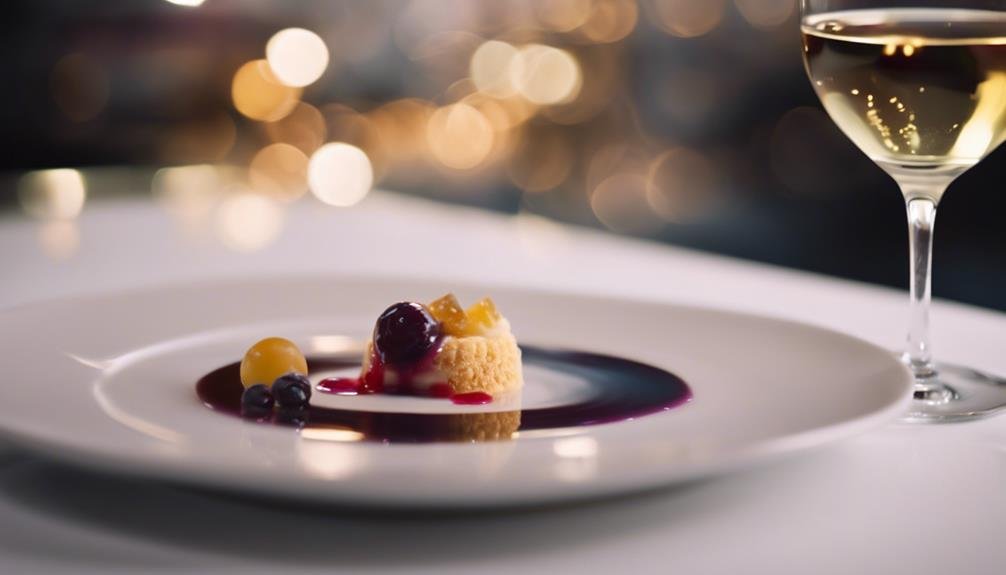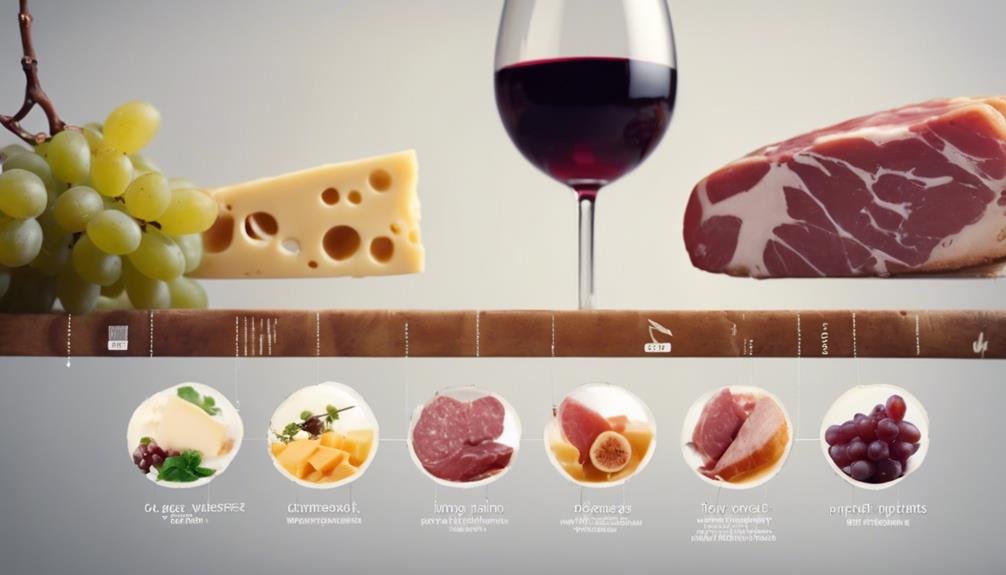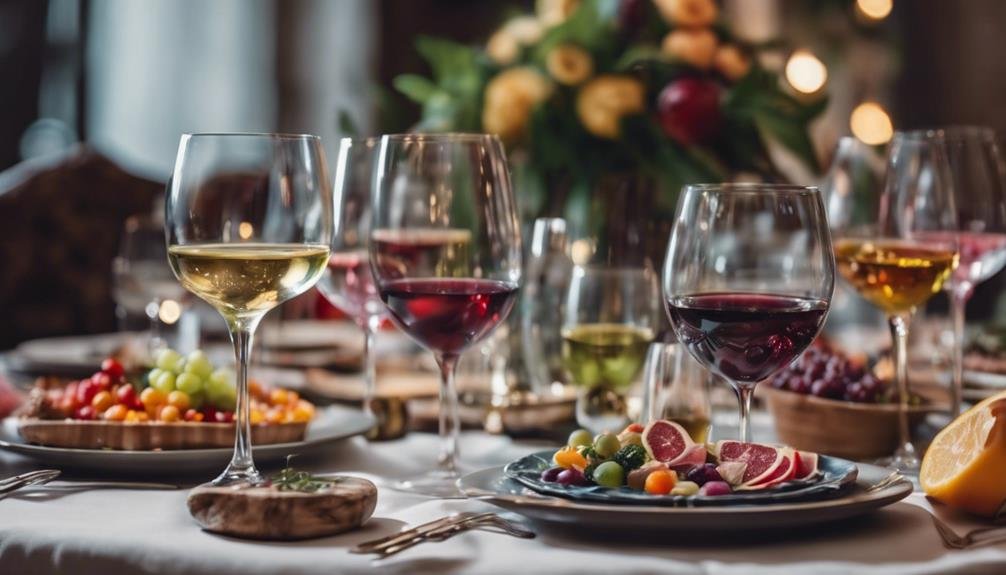To master food and wine pairing, consider wine characteristics like acidity, sweetness, tannins, and body, matching them to food flavors. Avoid common mistakes like mismatched tannins or unbalanced acidity. Seek harmony and contrasts in sweetness and acidity, enhancing the overall experience. Experiment with umami-rich ingredients for earthy pairings and texture contrasts. Utilize wine and food pairing charts for guidance, which offer visual aids and customized recommendations. Elevate your dining experience by understanding these principles, where wine nuances complement and enhance food flavors, creating a culinary symphony on your palate.
Understanding Wine Characteristics for Pairing
Understanding the key characteristics of wine is vital for successful food and wine pairing. Wine profiles, including flavor profiles, play a significant role in determining food compatibility based on palate preferences. Different wines exhibit varying levels of acidity, sweetness, tannins, and body, which can greatly impact the overall dining experience.
When selecting a wine to pair with a dish, it is essential to take into account the wine's flavor intensity, fruitiness, and aroma. For instance, a light-bodied, crisp white wine may complement seafood dishes, while a full-bodied red wine with high tannins may pair well with red meat.
Avoiding Common Food and Wine Pairing Mistakes
To achieve successful food and wine pairings, it is important to be mindful of common mistakes that can detract from the overall dining experience. When pairing food and wine, consider the following to avoid common pitfalls:
- Avoiding Mismatched Tannin Textures: Make sure that the tannins in the wine do not overpower the dish. High-tannin wines can clash with delicate, light dishes.
- Sweetness Contrasts: The wine should be sweeter than the food it accompanies. Mismatched sweetness levels can lead to an unbalanced pairing.
- Balancing Acidity: Select a wine with higher acidity than the food to complement flavors. Balanced acidity levels can enhance the overall dining experience.
- Seeking Flavor Harmony: Pair earthy wines with earthy dishes for a more cohesive taste profile. Matching flavors can elevate the enjoyment of both the wine and the food.
Ensuring Balance in Sweetness and Acidity

Achieving a harmonious balance between sweetness and acidity is vital in the art of food and wine pairing. Sweetness balance and acidity contrast play pivotal roles in creating flavor harmony and palate balance.
When pairing food and wine, it is important to make sure that the sweetness of the wine complements rather than overpowers the dish. Similarly, the acidity of the wine should contrast with the food to enhance the overall dining experience.
Enhancing Flavors With Earthy Pairings
Incorporating earthy elements into wine and food pairings can greatly enrich the flavors and overall dining experience. When aiming to enhance flavors with earthy pairings, consider the following:
- Umami Delights: Incorporate ingredients rich in umami, such as mushrooms, truffles, or soy sauce, to complement earthy wines like Pinot Noir or Nebbiolo.
- Bold Combinations: Experiment with bold combinations like pairing a robust Cabernet Sauvignon with a dish featuring roasted beets or grilled eggplant for a satisfying contrast.
- Balance is Key: Maintain a harmonious balance by matching the intensity of the earthy flavors in both the wine and the dish.
- Texture Play: Explore texture contrasts by pairing earthy wines with dishes that offer varying textures, enhancing the overall dining experience.
Exploring Wine and Food Pairing Chart Options

Exploration of Wine and Food Pairing Chart Options offers a detailed visual aid for optimizing culinary experiences through well-matched wine selections. These charts provide customized recommendations based on flavor profiles, allowing for interactive tools that enhance the pairing process.
By utilizing these visual aids, individuals can easily identify the ideal wine to complement specific dishes, ensuring a harmonious dining experience. Whether seeking to pair a bold red with a rich steak or a crisp white with seafood, these charts offer guidance for novices and enthusiasts alike.
With a variety of options available, including poster formats and online resources, exploring Wine and Food Pairing Chart Options can elevate the enjoyment of meals while expanding one's understanding of wine pairing principles.
Frequently Asked Questions
Can I Pair Spicy Food With Wine?
Pairing spicy cuisine with sweet wine can create a delightful contrast that enhances both flavors. Bold red wines can also complement spicy dishes by balancing the heat. Consider the intensity of the spice and wine flavors for a harmonious pairing.
How Do I Pair Wine With Seafood?
Pairing wine with seafood involves selecting white wine options to complement the delicate flavors of shellfish. Opt for crisp and acidic whites like Sauvignon Blanc or Chardonnay to enhance the seafood experience, creating a harmonious dining affair.
Is It Okay to Pair Red Wine With Cheese?
Pairing red wine with cheese can be delightful as the bold flavors complement each other. The rich, complex notes of red wine can enhance the creamy textures of cheese. For a harmonious pairing, opt for aged cheeses with robust red wines.
What Wine Goes Well With Dessert?
When it comes to dessert, opt for sweet wines like champagne, which beautifully complement fruit tarts or chocolate decadence. The delicate effervescence and luscious sweetness of these wines elevate the dessert experience, creating a harmonious and indulgent finale to your meal.
How Do I Pair Wine With Vegetarian Dishes?
When pairing wine with vegetarian dishes, consider vegan options and plant-based pairings. Choose wines that complement the flavors of the vegetables, avoiding overpowering tannins. Opt for higher acidity wines to balance the dish, enhancing the dining experience.
Conclusion
In the intricate dance of food and wine pairing, mastering the art requires a delicate balance of flavors and textures. By understanding the characteristics of each wine selection and avoiding common pairing mistakes, one can create harmonious culinary experiences.
Remember, the key to revealing the full potential of a dining experience lies in the thoughtful interplay between food and wine. So, raise your glass and savor the irony of how the simplest of pairings can create the most memorable moments of gastronomic pleasure.
